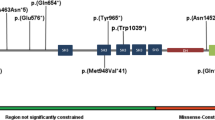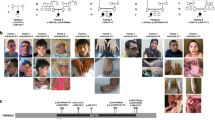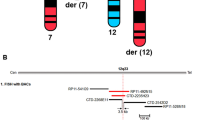Abstract
Recent studies have shown that more than 10% of autism cases are caused by de novo structural genomic rearrangements. Given that some heritable copy number variants (CNVs) have been observed in patients as well as in healthy controls, to date little attention has been paid to the potential function of these non-de novo CNVs in causing autism. A normally intelligent patient with autism, with non-affected parents, was identified with a maternally inherited 10 Mb deletion at 13q21.2. Sequencing of the genes within the deletion identified a paternally inherited nonsynonymous amino-acid substitution at position 614 of diaphanous homolog 3 (DIAPH3) (proline to threonine; Pro614Thr). This variant, present in a highly conserved domain, was not found in 328 healthy subjects. Experiments showed a transient expression of Diaph3 in the developing murine cerebral cortex, indicating it has a function in brain development. Transfection of Pro614Thr in murine fibroblasts showed a significant reduction in the number of induced filopodia in comparison to the wild-type gene. DIAPH3 is involved in cell migration, axon guidance and neuritogenesis, and is suggested to function downstream of SHANK3. Our findings strongly suggest DIAPH3 as a novel autism susceptibility gene. Moreover, this report of a ‘double-hit’ compound heterozygote for a large, maternally inherited, genomic deletion and a paternally inherited rare missense mutation shows that not only de novo genomic variants in patients should be taken seriously in further study but that inherited CNVs may also provide valuable information.
This is a preview of subscription content, access via your institution
Access options
Subscribe to this journal
Receive 12 print issues and online access
$259.00 per year
only $21.58 per issue
Buy this article
- Purchase on Springer Link
- Instant access to full article PDF
Prices may be subject to local taxes which are calculated during checkout




Similar content being viewed by others
References
Freitag CM . The genetics of autistic disorders and its clinical relevance: a review of the literature. Mol Psychiatry 2007; 12: 2–22.
Persico AM, Bourgeron T . Searching for ways out of the autism maze: genetic, epigenetic and environmental clues. Trends Neurosci 2006; 29: 349–358.
Beaudet AL . Autism: highly heritable but not inherited. Nat Med 2007; 13: 534–536.
Sebat J, Lakshmi B, Malhotra D, Troge J, Lese-Martin C, Walsh T et al. Strong association of de novo copy number mutations with autism. Science 2007; 316: 445–449.
Szatmari P, Paterson AD, Zwaigenbaum L, Roberts W, Brian J, Liu XQ et al. Mapping autism risk loci using genetic linkage and chromosomal rearrangements. Nat Genet 2007; 39: 319–328.
Vorstman JA, Staal WG, van Daalen E, van Engeland H, Hochstenbach PF, Franke L . Identification of novel autism candidate regions through analysis of reported cytogenetic abnormalities associated with autism. Mol Psychiatry 2006; 11: 18–28.
Marshall CR, Noor A, Vincent JB, Lionel AC, Feuk L, Skaug J et al. Structural variation of chromosomes in autism spectrum disorder. Am J Hum Genet 2008; 82: 477–488.
Weiss LA, Shen Y, Korn JM, Arking DE, Miller DT, Fossdal R et al. Association between microdeletion and microduplication at 16p11.2 and autism. N Engl J Med 2008; 358: 667–675.
Murphy KC, Jones LA, Owen MJ . High rates of schizophrenia in adults with velo-cardio-facial syndrome. Arch Gen Psychiatry 1999; 56: 940–945.
Vorstman JAS, Morcus MEJ, Duijff SN, Klaassen PWJ, Heineman-de Boer JA, Beemer FA et al. The 22q11.2 deletion in children: high rate of autistic disorders and early onset of psychotic symptoms. J Am Acad Child Adolesc Psychiatry 2006; 45: 1104–1113.
Pulver AE, Nestadt G, Goldberg R, Shprintzen RJ, Lamacz M, Wolyniec PS et al. Psychotic illness in patients diagnosed with velo-cardio-facial syndrome and their relatives. J Nerv Ment Dis 1994; 182: 476–478.
Veltman MW, Craig EE, Bolton PF . Autism spectrum disorders in Prader–Willi and Angelman syndromes: a systematic review. Psychiatr Genet 2005; 15: 243–254.
Kaufman J, Birmaher B, Brent D, Rao U, Flynn C, Moreci P et al. Schedule for Affective Disorders and Schizophrenia for School-Age Children-Present and Lifetime Version (K-SADS-PL): initial reliability and validity data. J Am Acad Child Adolesc Psychiatry 1997; 36: 980–988.
Lord C, Risi S, Lambrecht L, Cook Jr EH, Leventhal BL, DiLavore PC et al. The autism diagnostic observation schedule-generic: a standard measure of social and communication deficits associated with the spectrum of autism. J Autism Dev Disord 2000; 30: 205–223.
Lord C, Rutter M, Le Couteur A . Autism Diagnostic Interview-Revised: a revised version of a diagnostic interview for caregivers of individuals with possible pervasive developmental disorders. J Autism Dev Disord 1994; 24: 659–685.
Wechsler D, Kort W, Compaan EL, Bliechrodt N, Resig WCM, Schittekatte M et al. WISC-III NL, Handleiding. Psychological Corporation Unlimited: London, UK, 2002.
Andreasen NC, Flaum M, Arndt S . The Comprehensive Assessment of Symptoms and History (CASH). An instrument for assessing diagnosis and psychopathology. Arch Gen Psychiatry 1992; 49: 615–623.
Siepel A, Bejerano G, Pedersen JS, Hinrichs AS, Hou M, Rosenbloom K et al. Evolutionarily conserved elements in vertebrate, insect, worm, and yeast genomes. Genome Res 2005; 15: 1034–1050.
van der Zwaag B, Burbach JP, Scharfe C, Oefner PJ, Brunner HG, Padberg GW et al. Identifying new candidate genes for hereditary facial paresis on chromosome 3q21-q22 by RNA in situ hybridization in mouse. Genomics 2005; 86: 55–67.
Higgs HN . Formin proteins: a domain-based approach. Trends Biochem Sci 2005; 30: 342–353.
Pellegrin S, Mellor H . The Rho family GTPase Rif induces filopodia through mDia2. Curr Biol 2005; 15: 129–133.
Steele MM, Al Adeimi M, Siu VM, Fan YS . Brief report: a case of autism with interstitial deletion of chromosome 13. J Autism Dev Disord 2001; 31: 231–234.
Wong KK, deLeeuw RJ, Dosanjh NS, Kimm LR, Cheng Z, Horsman DE et al. A comprehensive analysis of common copy-number variations in the human genome. Am J Hum Genet 2007; 80: 91–104.
Mills RE, Luttig CT, Larkins CE, Beauchamp A, Tsui C, Pittard WS et al. An initial map of insertion and deletion (INDEL) variation in the human genome. Genome Res 2006; 16: 1182–1190.
Evangelista M, Zigmond S, Boone C . Formins: signaling effectors for assembly and polarization of actin filaments. J Cell Sci 2003; 116: 2603–2611.
Katoh M, Katoh M . Identification and characterization of human DIAPH3 gene in silico. Int J Mol Med 2004; 13: 473–478.
Sidman RL, Rakic P . Neuronal migration, with special reference to developing human brain: a review. Brain Res 1973; 62: 1–35.
Ponti A, Machacek M, Gupton SL, Waterman-Storer CM, Danuser G . Two distinct actin networks drive the protrusion of migrating cells. Science 2004; 305: 1782–1786.
Gupton SL, Eisenmann K, Alberts AS, Waterman-Storer CM . mDia2 regulates actin and focal adhesion dynamics and organization in the lamella for efficient epithelial cell migration. J Cell Sci 2007; 120: 3475–3487.
Yang C, Czech L, Gerboth S, Kojima S, Scita G, Svitkina T . Novel roles of formin mDia2 in lamellipodia and filopodia formation in motile cells. PLoS Biol 2007; 5: e317.
Dent EW, Kwiatkowski AV, Mebane LM, Philippar U, Barzik M, Rubinson DA et al. Filopodia are required for cortical neurite initiation. Nat Cell Biol 2007; 9: 1347–1359.
Kwiatkowski AV, Rubinson DA, Dent EW, Edward van Veen J, Leslie JD, Zhang J et al. Ena/VASP is required for neuritogenesis in the developing cortex. Neuron 2007; 56: 441–455.
Hotulainen P, Llano O, Smirnov S, Tanhuanpaa K, Faix J, Rivera C et al. Defining mechanisms of actin polymerization and depolymerization during dendritic spine morphogenesis. J Cell Biol 2009; 185: 323–339.
Durand CM, Betancur C, Boeckers TM, Bockmann J, Chaste P, Fauchereau F et al. Mutations in the gene encoding the synaptic scaffolding protein SHANK3 are associated with autism spectrum disorders. Nat Genet 2007; 39: 25–27.
Moessner R, Marshall CR, Sutcliffe JS, Skaug J, Pinto D, Vincent J et al. Contribution of SHANK3 mutations to autism spectrum disorder. Am J Hum Genet 2007; 81: 1289–1297.
Gauthier J, Spiegelman D, Piton A, Lafreniere RG, Laurent S, St-Onge J et al. Novel de novo SHANK3 mutation in autistic patients. Am J Med Genet B Neuropsychiatr Genet 2009; 150B: 421–424.
Roussignol G, Ango F, Romorini S, Tu JC, Sala C, Worley PF et al. Shank expression is sufficient to induce functional dendritic spine synapses in aspiny neurons. J Neurosci 2005; 25: 3560–3570.
Qin J, Jia M, Wang L, Lu T, Ruan Y, Liu J et al. Association study of SHANK3 gene polymorphisms with autism in Chinese Han population. BMC Med Genet 2009; 10: 61.
Sykes NH, Toma C, Wilson N, Volpi EV, Sousa I, Pagnamenta AT et al. Copy number variation and association analysis of SHANK3 as a candidate gene for autism in the IMGSAC collection. Eur J Hum Genet 2009; 17: 1347–1353.
Naisbitt S, Kim E, Tu JC, Xiao B, Sala C, Valtschanoff J et al. Shank, a novel family of postsynaptic density proteins that binds to the NMDA receptor/PSD-95/GKAP complex and cortactin. Neuron 1999; 23: 569–582.
Palmen SJ, Van EH, Hof PR, Schmitz C . Neuropathological findings in autism. Brain 2004; 127: 2572–2583.
Spalice A, Parisi P, Nicita F, Pizzardi G, Del BF, Iannetti P . Neuronal migration disorders: clinical, neuroradiologic and genetics aspects. Acta Paediatr 2009; 98: 421–433.
Glessner JT, Wang K, Cai G, Korvatska O, Kim CE, Wood S et al. Autism genome-wide copy number variation reveals ubiquitin and neuronal genes. Nature 2009; 459: 569–573.
Cusco I, Medrano A, Gener B, Vilardell M, Gallastegui F, Villa O et al. Autism-specific copy number variants further implicate the phosphatidylinositol signaling pathway and the glutamatergic synapse in the etiology of the disorder. Hum Mol Genet 2009; 18: 1795–1804.
Zhao X, Leotta A, Kustanovich V, Lajonchere C, Geschwind DH, Law K et al. A unified genetic theory for sporadic and inherited autism. Proc Natl Acad Sci USA 2007; 104: 12831–12836.
Janecke AR, Thompson DA, Utermann G, Becker C, Hubner CA, Schmid E et al. Mutations in RDH12 encoding a photoreceptor cell retinol dehydrogenase cause childhood-onset severe retinal dystrophy. Nat Genet 2004; 36: 850–854.
Girardet A, Guittard C, Altieri JP, Templin C, Stremler N, Beroud C et al. Negative genetic neonatal screening for cystic fibrosis caused by compound heterozygosity for two large CFTR rearrangements. Clin Genet 2007; 72: 374–377.
Budarf ML, Konkle BA, Ludlow LB, Michaud D, Li M, Yamashiro DJ et al. Identification of a patient with Bernard-Soulier syndrome and a deletion in the DiGeorge/velo-cardio-facial chromosomal region in 22q11.2. Hum Mol Genet 1995; 4: 763–766.
O’Roak BJ, State MW . Autism genetics: strategies, challenges, and opportunities. Autism Res 2008; 1: 4–17.
Wheeler DA, Srinivasan M, Egholm M, Shen Y, Chen L, McGuire A et al. The complete genome of an individual by massively parallel DNA sequencing. Nature 2008; 452: 872–876.
Levy S, Sutton G, Ng PC, Feuk L, Halpern AL, Walenz BP et al. The diploid genome sequence of an individual human. PLoS Biol 2007; 5: e254.
Wang J, Wang W, Li R, Li Y, Tian G, Goodman L et al. The diploid genome sequence of an Asian individual. Nature 2008; 456: 60–65.
Bentley DR, Balasubramanian S, Swerdlow HP, Smith GP, Milton J, Brown CG et al. Accurate whole human genome sequencing using reversible terminator chemistry. Nature 2008; 456: 53–59.
Acknowledgements
We thank Eric Strengman and Eric Rappaport for their technical support with the sequencing experiments and Harry Mellor (University of Bristol, UK) for proving us with mDia2 and RifQL expression vectors. We thank Corlinda ten Brink for help with confocal microscopy and Petra Baarendse for help with statistical analyses. We also thank Jacky Senior for the careful language corrections of the paper.
Author information
Authors and Affiliations
Corresponding author
Ethics declarations
Competing interests
The authors declare no conflict of interest.
Rights and permissions
About this article
Cite this article
Vorstman, J., van Daalen, E., Jalali, G. et al. A double hit implicates DIAPH3 as an autism risk gene. Mol Psychiatry 16, 442–451 (2011). https://doi.org/10.1038/mp.2010.26
Received:
Revised:
Accepted:
Published:
Issue Date:
DOI: https://doi.org/10.1038/mp.2010.26
Keywords
This article is cited by
-
Diaph3 underlines tumor cell heterogeneity in glioblastoma with implications for treatment modalities resistance
Journal of Neuro-Oncology (2022)
-
Identification of primary copy number variations reveal enrichment of Calcium, and MAPK pathways sensitizing secondary sites for autism
Egyptian Journal of Medical Human Genetics (2020)
-
Autism genetics: opportunities and challenges for clinical translation
Nature Reviews Genetics (2017)
-
Genetische Befunde bei Autismus-Spektrum-Störungen
Der Nervenarzt (2017)
-
Lack of Diaph3 relaxes the spindle checkpoint causing the loss of neural progenitors
Nature Communications (2016)



